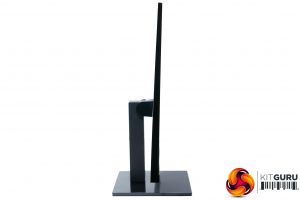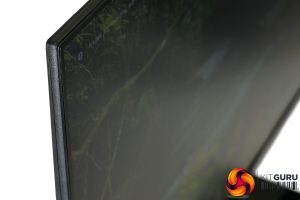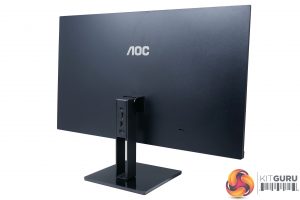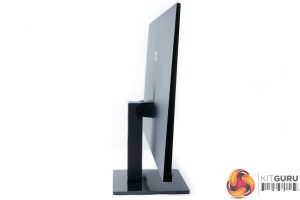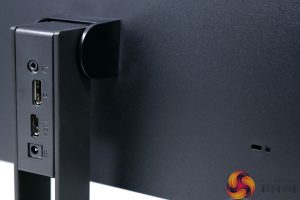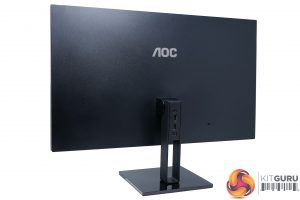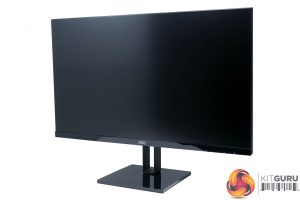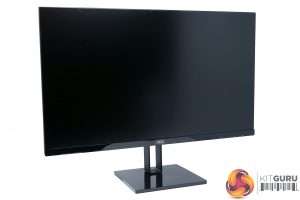The slimness of this monitor is striking. We’ve only ever seen OLED displays this thin before and it really does make a difference to the feel of having a large display on your desk, especially when combined with the very narrow, low-profile bezels.
The rest of the design is smart too. The bottom bezel and base have a simple glossy black finish while the stand just consists of two slim metal uprights. Meanwhile, round the back you get a matt black finish to the rear of the screen and the rest of the very simple metal stand.
The styling really is top notch with a refined minimalism that’s sure to help smarten up any desk space. That said, the build quality isn’t all that amazing.
The glossy black plastic for the base and bottom bezel looks nice enough but is going to scratch very easily and show the dust, too. Meanwhile both the glossy and matt plastic finishes suffer from being such large, flat expanses. Because there are no natural curves to break up the lines, it’s obvious when you get a slight wobble to the surface.
By and large you won’t notice these issues but considering how design-focussed this display is, it’s worth noting – you’re unlikely to mistake this display for something truly high-end.
Perhaps the biggest compromise with this monitor is its lack of options for positioning the display. The stand only offers tilt adjustment, with height, rotation and pivot movements all unaccounted for. Moreover, there’s no option to remove the stand and fit an alternative monitor mount either. Such is the price of going for such a thin screen design.
There’s a good reason for this, though, which is that in order to make the screen so thin, AOC has had to move all the display’s connectivity onto the stand. Here you’ll find the power, video (1 x DisplayPort, 1 x HDMI) and headphone sockets with their connection to the display running up through the centre of the stand.
It’s a neat solution that also makes it much easier to keep your cabling tidy, though inevitably this does mean you miss out on any extras such as a USB hub or second HDMI socket. You’ll also not be surprised to learn there are no speakers in this monitor.
Another compromise of the slim design is that the power supply has had to be moved outside the monitor. So, instead of a three-pronged kettle lead mains connection, the display has a small barrel connection for power and an external power brick that is thankfully small.
The only features you’ll find on the screen itself are a Kensington lock slot on the back and the OSD and power buttons under the bottom bezel.
As for the LCD panel, it’s 27-inches from corner to corner and has a 1080p resolution. This may be a bit of a sticking point for some buyers, as a higher 1440p resolution is common for a screen this size and is the size/resolution that we’d normally opt for. The greater number of pixels makes for a sharper image and a larger desktop area to work on.
However, some users are happy with, or actively prefer, a lower resolution so we’ll leave the judgement up to you. For reference, a 27-inch display with a 1440p resolution has a pixel density of 110ppi whereas here it’s 82ppi.
Meanwhile, the use of an IPS panel should ensure good viewing angles and better colour reproduction than cheaper TN panels, though if high contrast is your thing you may prefer to seek out a VA panel. The panel uses 6-bit colour processing with FRC, so won’t offer quite the colour fidelity of true 8-bit panels but it should be fine for general use – if you’re looking for a professional quality display for image and video editing, this won’t be an ideal choice.
With a native 75Hz refresh rate, the 27V2Q offers a slight boost in gaming performance over bog standard screens. You also get Freesync for eliminating screen tear and stutter when used with AMD graphics cards.
 KitGuru KitGuru.net – Tech News | Hardware News | Hardware Reviews | IOS | Mobile | Gaming | Graphics Cards
KitGuru KitGuru.net – Tech News | Hardware News | Hardware Reviews | IOS | Mobile | Gaming | Graphics Cards


